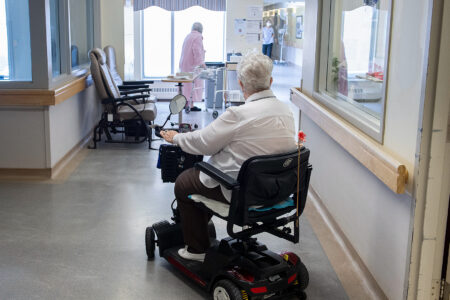
In virtually all western countries, COVID-19 has spread rapidly in long-term care (LTC), and where it has taken hold, mortality has been approximately 25 to 30 percent of all residents in a facility, making up anywhere from 62 to 82 percent of all COVID-19 deaths in Canada depending on the data source. These events have shed light on several long-term care policy practices that have been present for decades. The first of these is the contracting out of long-term care to facilities that operate outside the public healthcare system – a system with stronger infrastructure for infection prevention and greater accountability. The second is the practice of increasingly contracting out care to for-profit entities – many of which are large chains whose mandate has a potential to conflict with optimal care provision.
Residents of LTC care homes represent the frailest members of our communities. To qualify for residence in a publicly funded nursing home in many provinces, seniors need to have a high degree of dependency on others for their personal care (for example, washing, grooming and toileting) by virtue of advanced age and chronic disease. This dependency is called frailty, and frailty, far more than age, is a strong predictor of mortality.
The average length of stay in LTC, even with no pandemic, is approximately 12 to 24 months. The most important focus of care is optimizing quality of life in the days the residents have left, and optimizing end of life.
And while the propensity of the virus to attack and kill frail seniors is largely out of control of policy-makers, there are longstanding policy decisions related to LTC facility staffing and ownership that merit serious reflection.
LTC has never been part of the Canada Health Act, which requires hospital services to be publicly (government or quasi-government) owned and operated. This has meant that while all provinces provide some public funding for LTC, in most provinces only a minority of facilities are government owned and operated. Most of the care is contracted by government ministries of health to a mix of non-profit and for-profit facilities.
In British Columbia, for example, approximately one-quarter of LTC facilities are government (health authority) owned and operated, with non-profit and for-profit-owned facilities making up the remainder in approximate equal proportions. In Ontario, approximately 17 percent of facilities are delivered by government (municipal) homes, with 62 percent contracted to the for-profit sector and the remainder to the non-profit and charitable sector.
This system exists despite research that has consistently demonstrated that public and non-profit models tend to have better care outcomes for indicators such as pressure ulcers and hospital admissions. The most consistent reason for the differences in outcomes is that profit facilities, on average, hire fewer staff compared to both government-owned facilities and non-profit facilities.
A recent report by BC’s seniors’ advocate found the for-profit sector failed to deliver 207,000 hours of care they had received funds for. In contrast the non-profit sector provided 80,000 more hours of care than they were funded to deliver.
Research also demonstrates that facilities with lower staffing levels have higher turnover rates. Likewise, the practice of sub-contracting by facilities to outside agencies who often pay substandard wages and benefits compare to in-house staff, results in high turnover rates. Not surprisingly, research has also found that more staff is related to better care, that the highest staffed homes perform better across a range of care activities and that better quality is related to facilities with less staff turnover.
Despite this evidence, provincial and federal governments have for decades resisted setting minimum staffing standards and increasingly relied on the private for-profit sector to build new LTC beds, where the practice of further sub-contracting out care is not uncommon. Some for-profit entities “flip” contracts when contracted employees unionize, replacing workers with those from a non-unionized company to avoid bargaining for improved working conditions. The result has been a workforce of poorly paid workers, and a high proportion of them racialized and women. These individuals need to work at several facilities to support their families, carrying workload assignments of 10-15 residents per shift – a number far exceeding best-practice recommendations.
Enter COVID-19, with its easy uptake among frail seniors living in congregate settings and often in shared rooms. The pandemic came into workplace settings where staff commonly work while sick, where they move quickly between residents to manage already unsustainable workloads (making meticulous handwashing between residents difficult). Many caregivers have to work part-time and on a casual basis at two or more facilities to make ends meet. In this setting, LTC becomes a breeding ground for the virus to grow and multiply, and left unchecked, it can rapidly overwhelm a facility.
The public health response to nursing home outbreaks has helped to mitigate the course of outbreaks. In BC, this has included: rapid response support teams dispatched to facilities with outbreaks to support infection control education; added hands-on care; the provision of palliative care expertise; a good supply of PPE to ensure staff confidence in their ability to work safely; and widespread testing and contact tracing. Public health also changed the definition of “outbreak” from the previous requirement of two or more residents, to only one staff or one resident testing positive for the virus. This lowered the threshold for initiating response team support.
In addition to the above measures, stabilization of the workforce by raising the wages and improving working conditions, and restricting staff to work at one facility, are key strategies deployed in BC to reduce inter-facility spread. This strategy is part of a public health order that will last for only six months. It is hard to see how it will be possible to turn this evidence-informed policy backwards after the massive public dialogue on the importance of these workers.
The pandemic will undoubtedly continue for months to come. Further research will help us understand the macro (government policy level), meso (facility level) and micro (patient level) enablers and barriers for virus entry and spread into LTC facilities. Irrespective of this, it is clear that a much stronger role for public ownership and oversight of long-term care will make us better prepared for the next pandemic.
Public investment in for-profit-owned care homes should no longer be considered a credible policy option, nor should low wages, poor working conditions and high resident-to-staff ratios. It is also essential for government to mandate and fund resident-to-staff ratios consistent with the best evidence and a staffing model to accommodate the greater inefficiency associated with meticulous infection control (frequent handwashing, proper donning and doffing of PPE). Finally, we need to consider greater public financing of less institutionalized models of care using robust home care to support families who choose to and are able to provide care to frail loved ones at home.
This article is part of the Facing up to Canada’s long-term care policy crisis special feature.
For related content, check out the IRPP’s Faces of Aging research program.










